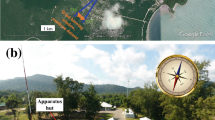Abstract
The turbulence structures near a sheared air-water interface were experimentally investigated with the hydrogen bubble visualization technique. Surface shear was imposed by an airflow over the water flow which was kept free from surface waves. Results show that the wind shear has the main influence on coherent structures under air-water interfaces. Low- and high- speed streaks form in the region close to the interface as a result of the imposed shear stress. When a certain airflow velocity is reached, “turbulent spots” appear randomly at low-speed streaks with some characteristics of hairpin vortices. At even higher shear rates, the flow near the interface is dominated primarily by intermittent bursting events. The coherent structures observed near sheared air-water interfaces show qualitative similarities with those occurring in near-wall turbulence. However, a few distinctive phenomena were also observed, including the fluctuating thickness of the instantaneous boundary layer and vertical vortices in bursting processes, which appear to be associated with the characteristics of air-water interfaces.
Similar content being viewed by others
References
Kline SJ. A brief history of boundary structure research. In: Panton RL ed. Self-Sustaining Mechanisms of Wall Turbulence. Southampton, Boston: Computational Mechanics Publications, 1997. 1–12
Robinson SK. Coherent motions in the turbulent boundary layer.Annu Rev Fluid Mech, 1991, 23: 601–639
Kline SJ, Robinson SK. Quasi-coherent structures in the turbulent boundary layer: Part I. Status report on a community-wide summary of the data. In: Kline SJ, Afgan NH eds. Near-Wall Turbulence, Proc Zoran Zaric Meml Conf, 1988. New York: Hemisphere Publishing Corporation, 1989. 200–217
Kim HT, Kline SJ, Reynolds WC. The production of turbulence near a smooth wall in a turbulent boundary layer.J Fluid Mech, 1971, 50: 133–160
Brumley BH, Jirka GH. Near-surface turbulence in a grid stirred tank.J Fluid Mech, 1987, 183: 235–263
Nezu I, Rodi WJ. Open channel flow measurements with a laser Doppler anemometer.J Hydraul Engng, 1986, 112: 335–345
Dickey TD, Martmau B, Mammoud D et al. A laboratory technique for investigating the relationship between gas transfer and fluid turbulence. In: Brutsaert W, Jirka GH eds. Gas Transfer at Water Surfaces. Reidel, 1984. 93–100
Komori S, Ueda H, Ogino F et al. Turbulence structure and transport mechanism at the free surface in an open channel flow.Int J Heat Mass Transfer, 1982, 25(4): 513–521
Rashidi M, Banerjee S. The effect of boundary conditions and shear rate on streak formation and breakdown in turbulent channel flows.Phys Fluids, 1990, 2(10): 1827–1838
Bruun HH. Hot-Wire Anemometry. Oxford, New York, Tokyo: Oxford University Press, 1995. 104
Schraub FA, Kline SJ, Henry J et al. Use of hydrogen bubbles for quantitative determination of time-dependent velocity fields in low-speed water flows.J Basic Engng. Trans ASME, 1965, 87: 429–444
Uzkan T, Reynolds WC. A shear-free turbulent boundary layer.J Fluid Mech, 1967, 28: 803–821
Theodorsen T. Mechanism of turbulence. In: Proc 2nd Midwestern Conf on Fluid Mech, Ohio State University, Columbus, Ohio, 1952. 1–18
Willmarth WW, Tu BJ. Structure of turbulence in the boundary layer near a wall.Phys Fluids, 1967, 10: S134–137
Offen GR, Kline SJ. A proposed model of the bursting process in turbulent boundary layers.J Fluid Mech, 1975, 70: 209–228
Smith CR, Walker JDA, Haidari AH et al. On the dynamics of near-wall turbulence.Phil Trans R Soc Lond A, 1991, 336: 131–175
Emmons HW. The laminar-turbulent transition in a boundary layer Part I.J Aero Sci, 1951, 18: 490–498
Perry AE, Lim TT, Teh EW. A visual study of turbulent spots.J Fluid Mech, 1981, 104: 387–405
Kumar S, Gupta R, Banerjee S. An experimental investigation of the characteristics of free-surface turbulence in channel flow.Phys Fluids, 1998, 10(2): 437–456
Author information
Authors and Affiliations
Additional information
The project supported by the National Natural Science Foundation of China (Grant No.19672070)
Rights and permissions
About this article
Cite this article
Shuangfeng, W., Fu, J., Zhennan, N. et al. An experimental study on turbulent coherent structures near a sheared air-water interface. Acta Mech Sinica 15, 289–298 (1999). https://doi.org/10.1007/BF02487927
Received:
Revised:
Issue Date:
DOI: https://doi.org/10.1007/BF02487927




